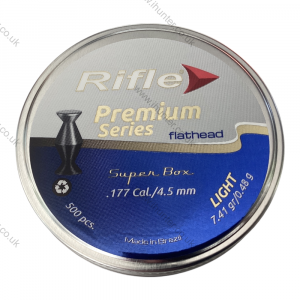The first step is if you have the manual to your specific air rifle then read it first. The manufacturer should have specific advice for the design of your rifle and that information supersedes anything else. There are two important reasons for this. First, the owner’s manual applies to that specific model so the information is exact. It is not simply about putting a couple of drops of oil on some part that your airgun doesn’t even have. Secondly, the information has been prepared by experts who are extremely knowledgeable about your airgun and how it functions
Cleaning The Inside Of The Barrel
Now this is a hotly disputed topic, as some people say never clean the inside of a barrel. There should be no need unless you introduce direst and foreign object directly into the barrel itself. Always look after your gun and it will always look after you. If accuracy does decline significantly over time then there are some methods to clean the inner barrel dependant on what type of airgun you have. There are specialised air gun cleaning kits you can buy on the market specifically for your rifle type. There is also now available cleaning pellets which will help clear any residue from the barrel.
However some manuals recommend , Clean the barrel bore regularly by using a suitable cleaning rod (Norica Storm Classic)
Maintain Your Bluing / Outer Barrel
The outer metalwork of a traditional airgun has a finish on it called ‘bluing’. It needs protecting against rust caused through contact with moisture, not just water, but a damp atmosphere can be enough. So if you come in from a cold shoot remove the air rifle from the storage bag and allow it to come up to room temperature with good air circulating around it. When warm air meets cold air it produces moisture, that the last thing you want on your rifle. Wipe the dry surfaces with an oily rag, perhaps an old linen tea towel impregnated with Ballistol. Place in the storage bag once its back to room temperature.
Storage Advice
Ensure that you do keep the air rifle in a secure place ideally within the air rifle bag. If you have a scope fitted make sure that it will not be exposed to any possible contact from the surrounding environment, the last thing you want to be doing is zeroing your sites every time you go out to shoot.
Storing A Break Barrel Rifle
When you take your last shot of the day make sure it is for 2 reasons, you don’t want to break the barrel again and put the spring/piston under stress while storing. Secondly it’s not advised to leave your gun in storage with a live pellet in there.
Storing A PCP Air Rifle
Ensure that you store the PCP with the manufactures minimum charge in the reservoir. Keeping positive pressure in the tank prevents outside air from coming in. For your rifle, the pressure in the reservoir prevents ambient (and damp) air from getting into your rifle. Your manufacturer will specify a minimum storage pressure. We do sell air rifle gas canisters.
Oiling The Air Rifle
First of all referral to the owners manual to ensure that you do not pt all on something you shouldn’t. The valves of air and CO2 guns need a small amount of lubricant. gun oil is needed for the job. A drop of Oil on the end of a CO2 cylinder is sufficient to lubricate the seals that engage the neck of the cylinder.
https://ihunter.co.uk/product/cleaning-177-maintenance-airgun/
The Action
The only other lubrication that your rifle will occasionally need after use is a very small smear of light grease on the sides of action where the barrel pivots. Never use oils containing silicone as they can cause damage to metal surfaces
Woodwork Stock
If your stock is either plastic or composite material then just a quick wipe with a soft cloth will be enough to maintain it. If your stock is made from wood then it needs a little more care. Airguns make use of a variety of different woods. Such as beech and hardwood, although these are varnished at the manufacturing stage, over time the wood can show the effects of general wear and tear. Always wipe down the stock when wet and occasionally adding a little stock oil will help preserve the wood.
Rifle Rest
You can buy a combined toolbox and rifle stand to make working on your gun easier. By having your air rifle supported, both hands are left free to work with. t supports the rifle while you work away on it. Also when you have completed the maintenance you can step back and admire your air rifle. Another good purpose for the rifle rest is that if you decide to sell your air rifle privately it is great for taking picture of the gun. You are much more likely too sell your air gun with a set of good images rather than just lying it on the floor and taking a few snaps.
Scopes Lenses
Always keep your lenses covered when not shooting. The ideal solution is using a flip-up lens caps on your scope. You have to buy the correct size for your scope, of course. They simply push-fit over the ends and provide a semi-permanent lens cover that can be easily opened in the field. Flip-up lens caps protect the optics from dirt and rain whenever they are closed.
They also keep the glass elements clean in your storage. Dependant on the type of lens you have, you may want to apply some rain X (water repellent glass treatment). Some scopes come already treated with a water repellent product straight out of the box. Ideally always carry a lens cloth with you. How to zero a scope.
Storing Your Pellets
The pellets are best stored in the tin or container they came in. There are some nice leather pouches on the market, however, the soft leather causes oxidation due to the tanning process so its not a good idea to use these.
Mechanical Maintenance
Again first read your manual
Fixings
Regularly check the tightness of all fixings. Do not over-tighten, some parts are made from aluminium, stripped threads will result from over-tightening
Trigger Maintenance
If you are unsure on what you are actually doing then take it to a dealer or someone who is experienced in this type of work. Dependant on the type of rifle you have there may be some adjusts on the trigger mechanisms. The first adjust its the length of pull before actually firing. The next is the sensitivity, make this too light then you will have a dangerous weapon in you hands. Ensure that you have some resistance on the pull, if you are unsure either leave it at the factory settings. Or you could get the help of a seasoned pro, the air gun community are a very helpful, your just need to ask.
Some trigger mechanisms the trigger is two stage with adjustments on both stages. Be aware that adjustment to one screw will effect the adjustment of the other and the trigger will only work properly if there is the correct balance between the two. Also for any oiling of the trigger referred to the manual.
The Power Of The Air Rifle
You should always have the power of your air rifle re-checked following any maintenance or repair work as any repairs or adjustments could affect the power. It is your legal responsibility to make sure the air rifle remains below the legal limit of 12 ft-lb. The fx chronograph is very popular with our members for checking the legal limit of the air rifle.
If you are unsure of any of the terminology then here is iHunter’s handy guide on airgun terminology. Do you need air gun insurance?


